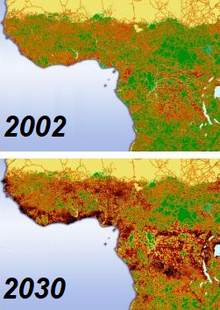
Back تجزؤ الموطن Arabic Раздробяване на местообитанията Bulgarian Fragmentacija staništa BS Fragmentació de l'hàbitat Catalan Habitattrennung German Fragmentasyonê habitati DIQ Habitata fragmentado Esperanto Fragmentación de hábitat Spanish Elupaiga fragmenteerumine Estonian گسستگی زیستگاه Persian



Habitat fragmentation describes the emergence of discontinuities (fragmentation) in an organism's preferred environment (habitat), causing population fragmentation and ecosystem decay.[2] Causes of habitat fragmentation include geological processes that slowly alter the layout of the physical environment[3] (suspected of being one of the major causes of speciation[3]), and human activity such as land conversion, which can alter the environment much faster and causes the extinction of many species. More specifically, habitat fragmentation is a process by which large and contiguous habitats get divided into smaller, isolated patches of habitats.[4][5]
- ^ "GLOBIO: Africa". GLOBIO. Archived from the original on 30 Oct 2005.
- ^ Schlaepfer, Daniel R.; Braschler, Brigitte; Rusterholz, Hans-Peter; Baur, Bruno (October 2018). "Genetic effects of anthropogenic habitat fragmentation on remnant animal and plant populations: a meta-analysis". Ecosphere. 9 (10). Bibcode:2018Ecosp...9E2488S. doi:10.1002/ecs2.2488. ISSN 2150-8925.
- ^ a b Sahney, S.; Benton, M. J.; Falcon-Lang, H. J. (1 December 2010). "Rainforest collapse triggered Pennsylvanian tetrapod diversification in Euramerica" (PDF). Geology. 38 (12): 1079–1082. Bibcode:2010Geo....38.1079S. doi:10.1130/G31182.1.
- ^ Fahrig, Lenore (2019). "Habitat fragmentation: A long and tangled tale". Global Ecology and Biogeography. 28 (1): 33–41. Bibcode:2019GloEB..28...33F. doi:10.1111/geb.12839. ISSN 1466-8238. S2CID 91260144.
- ^ Cite error: The named reference
Fahrig2003was invoked but never defined (see the help page).